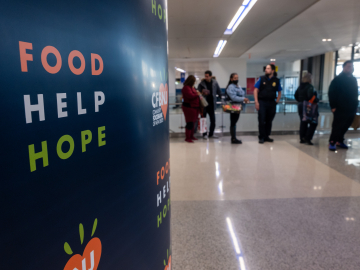To Challenge Big Tobacco’s Sales Pitch, Talk to Your City's Residents
In a recent Rio de Janeiro social media campaign, a fashionable young woman applies lipstick and impersonates a talking e-cigarette: “I have so many looks! I use perfume!” Smiling and playful at first, her expression suddenly turns sinister as, looking right into the camera, she tells her Gen Z peers that they have been horribly fooled. It was all a trick.
A series of similar videos from Rio’s public health authorities have drawn over 2 million views.
Teens are a known target for Big Tobacco. Alarmingly, 37 million 13–15-year-olds use tobacco. But they are not the only demographic being chased. The industry’s constant pursuit of new markets takes many forms, threatening public health gains in, for example, low-income and non-English-speaking communities. The tobacco industry’s tricks are constantly evolving; so too must our cities’ tactics.
In New York City and Rio de Janeiro, combining traditional regulation and enforcement with the voices of industry targets has proven the best way to push back. At a moment when content promoting e-cigarettes, nicotine pouches, and heated tobacco products has been viewed over 3.4 billion times on social media platforms, authentic community voices are needed more than ever.
This week, experts from our two cities are in Dublin for the World Conference on Tobacco Control, where e-cigarettes—and evidence of their mounting harms—were on the agenda. As world leaders in smoking reduction and members of the global Partnership for Healthy Cities network, we argue that local, community-led action is a crucial piece of the solution.
Cities have been at the forefront of efforts to stem tobacco’s devastating health impacts for decades—at first with regular cigarettes: New York City halved the adult smoking rate from 22% in 2002 to 11% in 2020 and then to 8% in 2023. Brazil also reduced smoking by half, between 1989 and 2008, and Rio instituted a smoke-free law, restricted advertising, and prioritized local enforcement and communication strategies. Smoking-related deaths have dropped dramatically in both cities.
But we cannot be complacent. We, as city governments, know our communities better than anyone: We know the parks where people spend their free time, the shops they frequent, and which populations are hardest for public health services to reach. This puts us in the right place to take effective action—starting with outreach and conversation.
In New York City, for example, certain communities are more exposed to harmful factors that encourage smoking and vaping (like industry marketing, retailer access, and stress) and fewer protective factors (like treatment support and access to behavioral health care). These concerns prompted the city to partner with several community-based organizations to hold in-person listening sessions. Insights from these sessions have already helped direct the city government’s data analysis efforts and highlighted important connections between mental health and vaping.
New York City also continues to use the courts, filing a federal lawsuit in April against nine of the largest nationwide disposable e-cigarette distributors. The defendants are alleged to be selling e-cigarettes online—violating nearly every applicable federal, New York state, and New York City law governing sales.
Meanwhile, strong national restrictions bolster Rio de Janeiro’s response. Last year, Brazil updated 2009 restrictions by banning the manufacture, import, sale, distribution, storage, transportation, and advertising of e-cigarettes. Then, this past April, Brazil ordered platforms including Instagram, YouTube, and TikTok to remove tobacco and e-cigarette ads.
Despite these policy wins, local data indicate worrying upward trends in usage and in illicit promotion of these devices, especially to young people. Alongside strengthened enforcement efforts, Rio is investing in targeted communication strategies to counteract the appeal of the products’ mind-numbing variety of flavors and colorful designs.
Just last month, Rio launched another e-cigarette campaign that includes youth-targeted messaging and draws on focus group data—again, leaning on the voices and experiences of communities targeted by industry marketing. The campaign counted 1.3 million social media views in less than four weeks.
The need for such targeted messaging is crucial if we are to counter the tobacco industry’s sales pitch. Indeed, their marketing strategy is not just that these products taste or look good. They also perpetuate a false narrative—that people who are just trying to quit smoking are the primary e-cigarette users. On the contrary, the vast majority of young adults who use e-cigarettes didn’t previously smoke. These products have put a new generation at risk.
Big Tobacco spends billions marketing its products to consumers. But, as cities have shown before, urban centers can be an unmatched force when it comes to fighting back. When we listen to and amplify the voices of targeted people in our communities, we give ourselves the best chance of winning—which in this case means saving lives.
We encourage other cities around the world to join us in the fight against the tobacco and vape companies and in support of the health of our residents. Only together can we adequately counter the industry’s tricks with our own tactics—especially this one, from the public health playbook: Always put those most affected front and center. That’s how real change takes root.
Leia em português / Read in Portuguese
Michelle Morse, MD, MPH, is acting health commissioner and chief medical officer of the New York City Department of Health and Mental Hygiene.
Daniel Soranz, MD, PhD, MPH, is the secretary of health for Rio de Janeiro, Brazil.
Join the 50,000+ subscribers in 170+ countries who rely on Global Health NOW summaries and exclusive articles for the latest public health news. Sign up for our free weekday newsletter, and please share the link with friends and colleagues.
An image from Rio de Janeiro's new social media campaign. Image courtesy of Vital Strategies.






